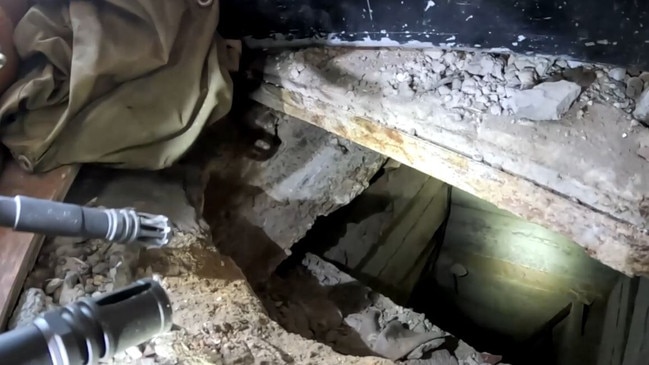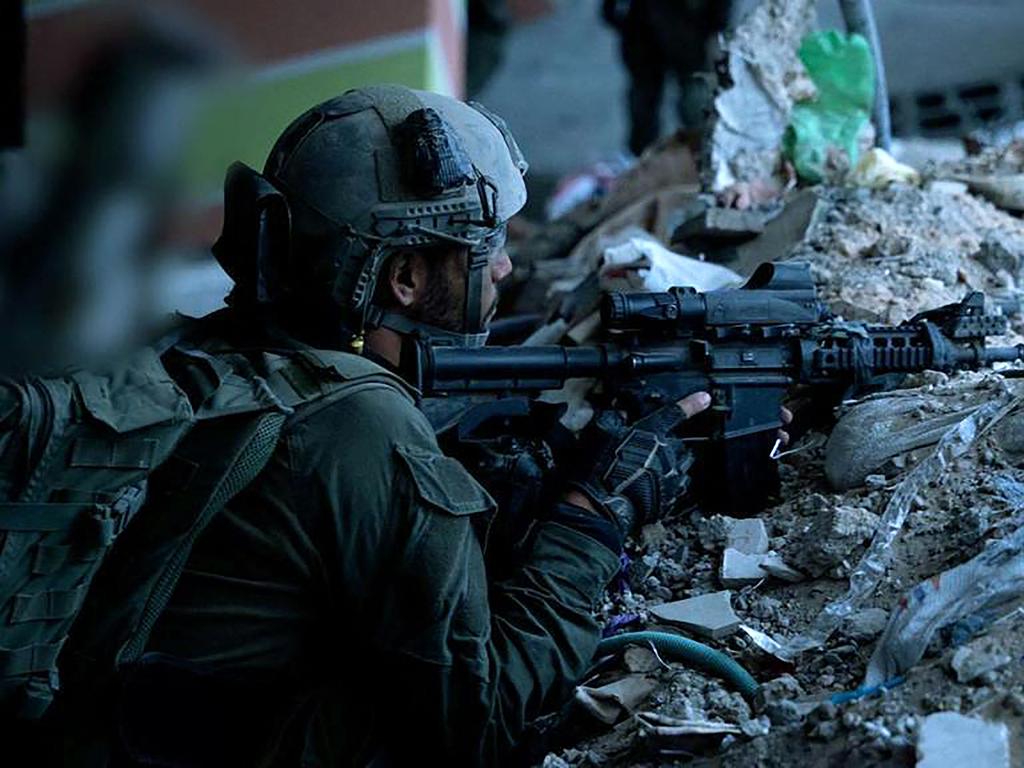IDF is flushing out Hamas tunnels with a liquid explosive gel
Warfare of this kind – along a network reaching up to 500km in length – hasn’t been encountered by an army since Vietnam.

From high above an evacuated hospital in the Gazan city of Beit Hanoun, a surveillance camera records a blast engulfing the medical facility, sending up a plume of thick black smoke. Moments later there’s more smoke to be seen, but it’s rising hundreds of metres away along the streetscape.
The result is the latest evolution in Israel’s assault on Hamas tunnelling. Combat engineers had poured several tonnes of liquid explosive into a shaft underneath the hospital, allowing it to flow freely and blow up the interior, along with stockpiled weaponry further up the pipeline, to expose the subterranean passage at the surface.
“The gel spread out and exploded whatever had been waiting for us in the tunnel,” said an Israel Defence Forces official at Tze’elim military base, not far from the border with the Gaza Strip, speaking on the condition that he not be identified.
Tunnel warfare of this kind hasn’t been encountered by an army since the Vietnam War, but soldiers who’ve operated in Gaza, and Hamas terrorists themselves, say the network reaches up to 500km in length, creating combat challenges the IDF is forced to answer in real time.
“This is nothing like Vietnam,” the official said. “It’s not in the jungles. It’s inside civilian populations – it’s the most complicated area to fight in. You set an explosive in one shaft, suddenly you see smoke 800m in another shaft. It’s a system, it’s not something local.”
The IDF’s deployment of liquid explosives removes the need to send troops into the tunnels. Instead, robots are dispatched to investigate the shaft openings and interiors, parts of which run 30m deep, sometimes more, and are often booby-trapped.
“We have other capabilities to understand where the tunnel is going. We don’t want to go down there,” the official said.
The extreme risks involved have already been felt by the IDF during its six-week campaign in Gaza. A week ago, four Israeli reservists were killed opening a booby-trapped shaft that exploded onto them, injuring four other soldiers in the same battalion.
Fighting terrorists on this turf undoubtedly gives Hamas a battlefield advantage, officials said, conceding that the tunnels are an engineering feat, involving bypasses, arches to prevent collapse, armoured doors, ventilation systems, electricity and communication lines. “It’s an underground city with all the infrastructure that we know,” the official said.
The IDF has studied the tunnels for years, but quantities of fresh intelligence have been amassed since the start of the incursion, and which continued this week with a long-awaited assault on al-Shifa Hospital, a suspected nerve centre for Hamas’s military activities and, possibly, a holding pen for Israeli civilians abducted on October 7.
On Friday morning (AEDT) the IDF confirmed that the body of 65-year-old Yehudit Weiss, taken captive from Kibbutz Be’eri, had been recovered from a structure adjacent to the hospital. Hours later, Israeli forces said they’d recovered the body of Corporal Noa Marciano, aged 19, from the same vicinity.
Videos released by the IDF suggest tunnel shafts are ubiquitous in Gaza, located in mosques, hospitals, and even inside a children’s classroom in Beit Hanoun.
Hamas commanders tend to have shafts built into their homes, the IDF official said, allowing them to make a quick escape into tunnel lines shared by their battalions in times of crisis.
Some 50 per cent of the shafts in Beit Hanoun have already been destroyed, he said, but eliminating entire tunnel systems across Gaza will take months, and is likely to involve a greater use of liquid explosives, which are pumped inside with a hose.
Still, there have been tunnels spared from destruction amid fears hostages may be inside of them. Airstrikes on military structures have been averted for the same reason, said a second IDF official with the rank of Colonel, who also spoke on condition of anonymity.
“There were many targets not struck because we assumed or thought it could endanger our hostages. It’s a very high consideration of ours,” he said. But Gazan civilians were also protected in many instances. He described ordering a building to be evacuated and watching a high-value Hamas man slip out in the throng of people. “We know the Hamas terrorist used the evacuation and escaped. We know it, and we pay those prices,” he said.
But on some occasions strikes have been ordered knowing civilians might be injured or killed – sometimes because the terrorists hold them as human shields and prevent them from escaping.
A week ago, ground troops became aware of Ahmed Siam, a Hamas company commander, who was said to be holding approximately 1000 civilians hostage inside Gaza’s al-Rantisi hospital, preventing them from evacuating to the south. Siam was killed two days later while hiding in a school with additional forces.
In cases where civilians are hurt, he said: “We’re not happy taking those decisions, sometimes we have to take those decisions knowing there will be casualties – and I can only say that we try to do everything we can to minimise it.”






To join the conversation, please log in. Don't have an account? Register
Join the conversation, you are commenting as Logout